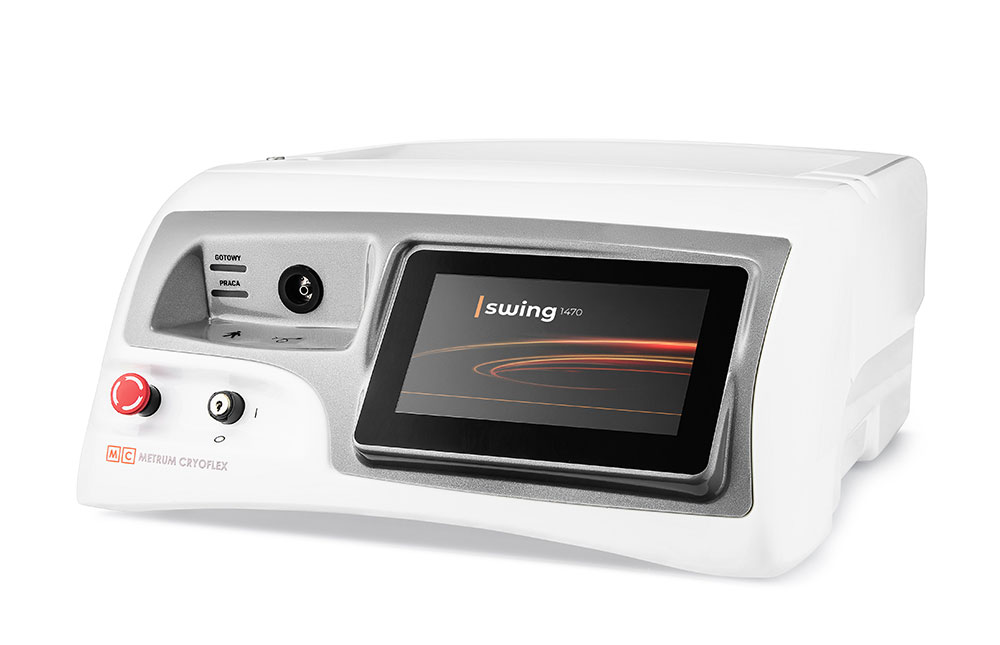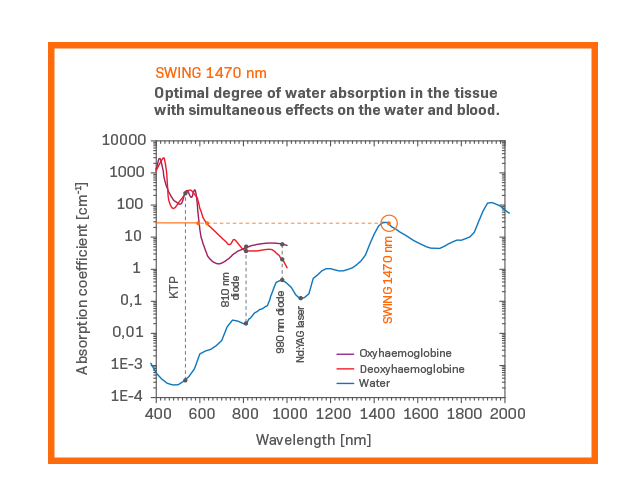SWING 15, diode laser 15 W, 1470 nm
In response to the emerging need for medical diode lasers dedicated for endoscopic, laparoscopic and robotic surgery, METRUM CRYOFLEX has introduced ingenious solution for more effective and safer procedures – Diode laser SWING – 1.5 μm.
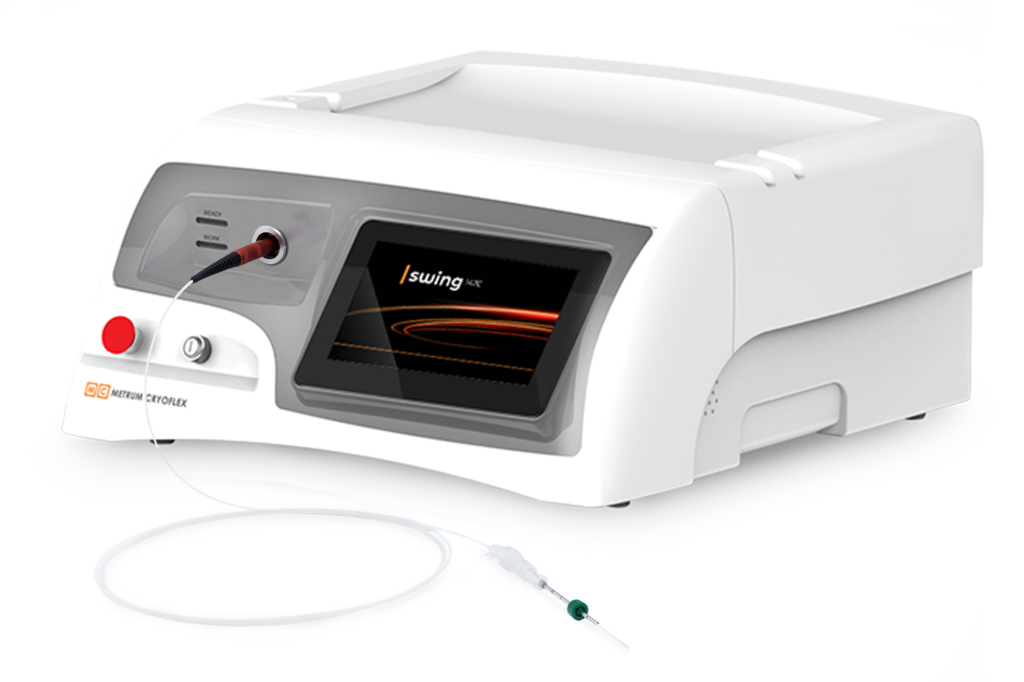
Biophysical characterisitics
Diode laser 1.5 μm is a perfect choice for minimally invasive procedures because of possibility to use different types of optical fibers: 400, 600 um. SWING 15 is indicated for all surgical applications requiring vaporization, incision, excision, ablation, cutting, haemostasis and coagulation of soft tissues. The 1.5 μm laser light beam has suitable low melanin and hemoglobin absorption for skin penetration and respectively high water and fat absorption for selective photothermolysis. The wave of the 1.5 μm laser is absorbed by cellular water 40 times better than the wave of 810/980 nm laser and 80 times better than the wave of Nd: YAG 1064 nm laser. The higher efficacy of the 1470 μm diode laser system enables to reduce energy emission with comparable clinical results to high power lasers of different wavelengths.
Touch screen panel for easier work
The SWING 15 diode laser is controlled from very high definition touch screen with excellent colour quality and a wide field of view, all this to provide the operator with ease of use. Individual user settings can be saved in the device, allowing quick and easy selection of treatment parameters.
The laser software allows for the energy emission in continuous wave (CW) mode, where the operator, based on the ultrasound mage (on-line), retracts the optical fibre in reaction to the visible response of the vein to the emission of energy.
The device software includes a mode of operation (Phlebology) enabling control of the vein ablation process by audibly informing the operator about delivering a programmed (or pre-set) dose of energy (J/cm) to the vein, thus determining the rate of optical fibre retraction from the treated vessel (sec/cm). After generating the desired energy dose, the laser automatically signals the optical fibre relocation time. The operator using this functionality can fully concentrate on tracking the ultrasound image without the need to control the laser operation.
The use of additional equipment such as “optical fibre retractor” is unnecessary, which reduces costs and also increases the quality and safety of the procedure.
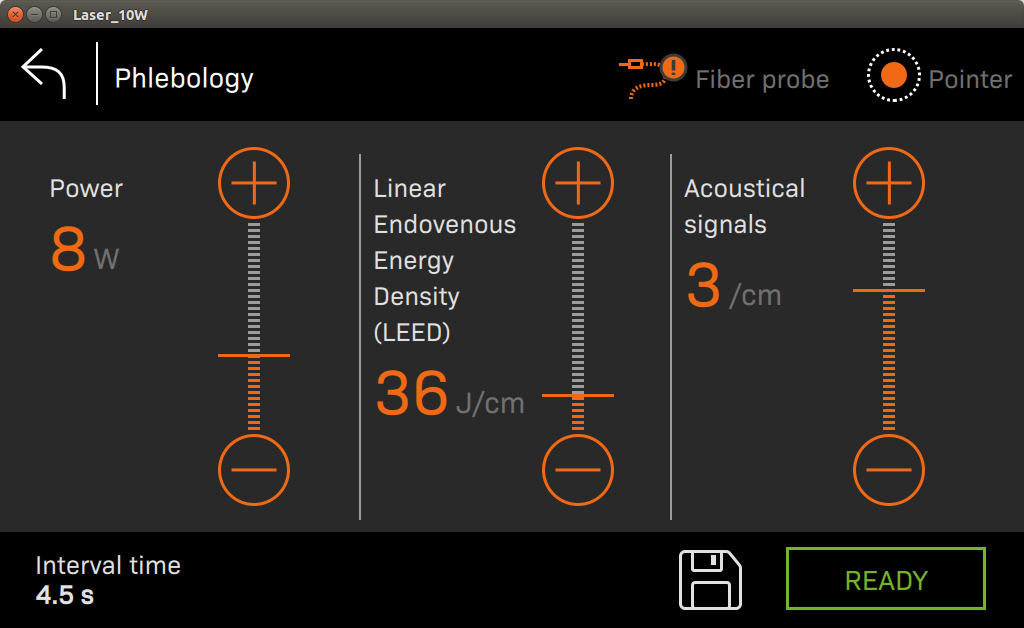
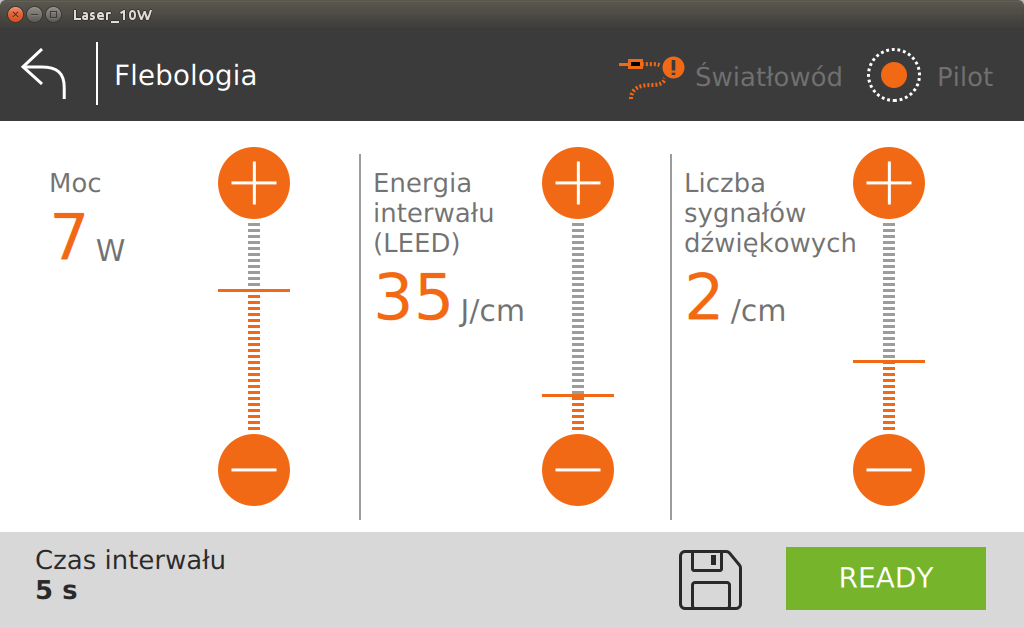
SWING 15 laser gives you possibility to change the layout colour. Depends on situation, lighting conditions you can choose white or black interface.
Technical specifications
SWING 15 – 1470 nm, 15 W
Main indications: ENT: dacryocystorhinostomy(DCR), turbinectomy, nasal polypectomy, tonsillectomy, glossectomy, endoscopic sinus surgery, stapedectomy, snoring, PHLEBOLOGY: EVLT (endovenous laser treatment) PROCTOLOGY: anal fistula, heamorrhoids
- Controlled by colour touch screen display
- Laser wave length: 1470 nm (semiconductor)
- Fiber core diameter: 400 um, 600 um, 800 um
- Output power (Laser): 15 Watt
- Thermoelectric cooling
- Aiming beam: 635 nm: adjustable
- Fiber coupling: SMA 905
- RFID fiber: Yes/No
- Treatment mode: CW, pulsed, QCW
- Time on: from 200 us (0,2 ms)
- Time off: from 200 us (0,2 ms)
- of impulses in package 1 – 100
- Dimension: 43/46/20 cm
- Weight: 13 kg
Specializations
EVLT
Endovenous occlusion of great saphenous vain and small saphenus vain
The procedure is performed under local anesthesia either in an outpatient setting or in the operating room. The endovenous method leaves no scars, minimizes the risk of infection and post procedural pain. It also gives excellent clinical and esthetical outcome with significant cost reduction. A distinctive post procedural pain decrease can be observed after 1470 nm laser treatment due to better light absorption inside the vein (40 times better than the wave of the 980 nm laser and 160 times better than the wave of the Nd: YAG 1064 nm laser).
Endovenus occlusion of perforating veins
The endovenous technique enables to occlude perforating veins under direct vision. It is faster and more effective that classical methods. Patients tolerate procedures very well and come back to normal activity very fast. According to research conducted on 1000 patients the technique is very successful. Positive results without any side effects like skin pigmentation could be observed at all patients. The procedure can be done even when a patient is on antithrombotic medications or suffers from circulatory incompetence.
EVLT- Ulceration treatment
- Endovenous approach: Under fluoroscopic guidance we introduce the catheter with thin optical fiber through the feeding vein on the ulceration site. Then, the feeding vein is enlightened on its entire length. The nonreversible laser ablation leads to the vessel occlusion and speeds up the healing processes.
- Percutaneous approach: Laser light is a well-known cure for faster healing of many injuries in cases of microcirculation reduction because it stimulates cellular growth. During the procedure, the injury is radiated crosswise on low power levels with the large spot ending. The photo stimulation is highly effective in diabetic foot treatment.
- Congenital venous malformations. By means of a mini incision, the selected fiber was introduced in the interior of the malformation and laser was applied on as much endothelial surface as possible,controlling emission of heat onto the skin.
Radial fibers
360° RADIAL TIP FIBER produced by METRUM CRYOFLEX applies energy faster and more accurately than any other fiber type in the endovenous market. FIBER (360°) used with SWING LASER ensures
energy emission that guarantees homogenous photothermal destruction of the vein wall, allowing safe closure of the vein. By avoiding perforation of the vein wall and associated thermal irritation of the surrounding tissue, intra- and post-operative pain is minimized, as are echymosis and other side-effects.
RADIAL FIBER provides simple and safe control and positioning of the fiber thanks to the excellent ultrasound visibility of the distal end of the fiber.
RADIAL FIBER is equipped with safety markings for optimal control of the pullback process.
M.I.L.H.
Laser Hemorrhidoplasty procedure (III, IV Grade) consists of interstitial introduction of laser light with the wavelength of 1470 nm by means of optical fiber with the sharp end. The procedure is performed under local anesthesia. It lasts for about 15 minutes. Normal daily activity is possible after the treatment. The risk of complications is negligible.
The light of the 1470 nm laser is characterized by a several dozen higher absorption in water in comparison with older generation lasers (810, 980 and 1064nm). Due to the fact that tissues contain significant amount of water, the change of absorption of light from hemoglobin to water protects the patients against deep penetration in the surrounding tissues. Controlled emission of laser energy obliterates the nodes from the insight, not destroying both the mucosa and the sphincter.
The advantages of the procedure
Owing to the homogenous radial emission of light with SWING 15, 1470 nm diode laser the following are obtained:
- Tissue reduction in hemorrhoid cushions (of the single segment or around the entire circumference).
- Maximal retention of muscle tissue or mucosa.
- Restoration of natural anatomical structure.
- No risk of sphincter damage.
Owing to the fact that no incision or stitching are use, the healing process in extremely fast. Patients experience less pot-operative pain and can come back to normal activity more quickly.
- No incision,
- No stitching,
- No open wounds.
Both in terms of post-operative pain and the recovery time, laser treatment is a better solution of conventional surgical procedures.
S.M.I.L.E.
Percutaneous Laser Disc Decompresion (PLDD) is the surgical removal of herniated disc/bulging disc material that presses on a nerve root or the spinal cord.
A percutaneous endoscopic laser discectomy is done when the patient’s history, physical examination and imaging (such as CT scan or MRI) indicates herniated or bulging disc and the material inside the disc has not ruptured into the spinal canal.
A Percutaneous Endoscopic Discectomy is used to treat the following conditions:
- Degenerative disc diseses
- Herniated disc
- Bulging disc
- Pinched nerve (nerve root compression)
- Sciatica
Through this working tube we insert the laser, camera, suction, irrigation and other surgical instruments. Once everything is in place, the surgeon utilizes a laser tovaporize the disc material, therefore diminishing the pressure on the spinal cord and/or the spinal nerve. Many patients feel immediate relief during the percutaneous endoscopic laser discectomy as the pressure is minimized. When the procedure is complete, the tube is slowly removed, allowing the muscles to move back into place.
A percutaneous endoscopic laser discectomy is a relatively short procedure, only taking half an hour to 45 minutes to perform with a quick recovery ensured afterwards. After 1-2 hours of monitoring, the patient (with a companion) is free to go.
Advantages of Percutaneous Endoscopic Discectomy and disc decompresion
- Outpatient procedure – no hospitalization
- No general anesthesia
- No arthrodesis (fusion)
- Minimally invasive
- Very successful
- Short recuperation – quickly return to normal activities
- Minimal scar tissue formation
MC FIBER – CERTIFICATED MEDICAL FIBER
Multipurpose optical fiber (400um, 600um diameter) with SMA 905 connection.
PLDD Procedure
Swing 1,5 µm laser, designed by METRUM CRYOFLEX under the EU Programme for Innovative Technologies, is the most technically advanced, and at the same time most versatile device of this kind available on the market. Exceptional characteristic of Swing laser is a unique combination of parameters: high potency of the device, optimal 1,5µm wavelength due to penetration in a hydrated tissue and the possibility to attach flexible, sterilizable optical fibers with even 200µm in diameter. It is an ideal device for minimally-invasive surgical procedures. It can be used in hysteroscopic and laparoscopic procedures as well as together with fiberscope. Swing diode laser assures better tissue homeostasis in comparison with CO2 laser. Due to the availability of a wide array of accessories, it is possible to perform surgeries in contact technique. Fiber only works at tissue contact site which limits the thermal effect only to the operated site (depth of vaporization – 0,5mm). A wide range of cannulas guiding the optical fiber enables to avoid the use of micromanipulator, indispensable in procedures with CO2 lasers.
Advantages
SWING lasers in gynecology:
- Precision – perfect cutting line; slight, thermal tissue damage – mostly white coagulation.
- Safety – very good coagulation of intraoperative bleeding and the lack of postoperative bleeding.
- Sterility.
- Versatility – one device for cutting, coagulation and vaporization.
Main indications
SWING laser in open and endoscopic surgery:
- Hysterescopy and laparoscopy
- Ablation
- Resection of endometriosis
- Cystectomy,
- Myomectomy
- Polypectomy
- Open surgery
- Coagulation of angiomas
SWING 1,5 nm is the state of art in laser construction and the gold standard in metastasis surgery on the lungs. It has an incredible physical characteristics which allows to save lung tissue, gentle and cost-effective as well as execute removal procedure of central and multiple tumors.
Well known in medical field precision resection is easily carried out with a sterile laser fiber by contacting with the tissue at a distance of a couple of millimeters from the tumor surface. The use of a laser fiber instead of a lens hand piece and the high output rating of the laser allow us to avoid overheating the lungs healthy tissue and guarantee a successful resection procedure. The fiber is comfortable to control and allow precise guidance like a scalpel and facilitates thanks to the direct contact with the tissue the cutting procedure in comparison with a lens hand piece. The heat occurring counteracts a tumor cell spread to the healthy tissue.
Thanks to this medical technique, a large number of metastases are now able to be removed from the lung without damages of the healthy tissue and losing blood. Now we can conduct treatments even of hard cases of inoperable patients making it cost-effective and efficient thanks to this technology.
Advantages of using Swing 1,5 um in Thoracic surgery
In addition to meastasis surgery, usage of 1470 nm diode laser gives you some extra benefits in other parenchyma resections on the lungs, such as segment resections. In that medical case, an anatomical resection can be conducted using the diode laser without any negative affect by the rigid geometry of an instrument as it is with bracket stitch devices.
- Cut and coagulate simultaneously
- Sealing properties provide smooth tissue surface
- Parenchyma-saving and lobe-sparing precise resection
- Deep and centrally located metastases can be exposed
- Re-treatment is possible with recurring metastases
- Precise resection of multiple metastases in only one procedure
- Best hemostasis
- Post-operative drainage can be removed shortly after treatment
Fibers
High quality silica/silica fiber with a wide range of application options.
Properties
- Suitable for 532 nm up to 2200 nm. The best choice for 940 nm and 1470 nm.
- Standard (SM) or high power (SL) F-SMA905 connector.
- Standard length 3 m, NA = 0.22
- Type of the fiber: disposable (ETO,sterilization double packed) and reusable (ETO, Steam, Plazma, sterilization).
One of the newest applications of the laser light emitted through diodes of different wavelengths and powers is laser lipolysis also called “small” liposuction.
SWING 1,5 µm is used in the procedure where localized fat deposits are reduced surgically by means of a special laser housed inside a tiny tube called a cannula. This procedure offers benefits on par with traditional liposuction, although it is generally recommended for smaller areas. In fact, this procedure is gaining popularity for use on the face, especially as a way of re-defining the jaw line, and getting rid of the dreaded “second chin” that creeps up on some of us as we get older.
Laser lipolysis technique
Laser lipolysis technique is based on selective activity of the laser beam on the fat tissue destroying thermally fat cells. The wave emitted by SWING 1,5 µm is similar to water and fat absorption peak (1500nm) and guarantees effective and painless liposuction of local fatness and bodyline shaping. The procedure is minimally invasive and can be conducted on an outpatient basis under local anesthesia. The additional advantage of the laser method is boosting flexibility and resiliency of the skin throught heating collagen fibres (skin tightening).
Advantages of using SWING 1,5 µm in Laser Lipolysis
Diode laser has many advantages over traditional liposuction. Firstly, it is gentler and safer, partly due to the much smaller cannulas. Secondly, the smaller cannulas mean smaller incisions, so there is less scarring. Finally, because of the heat generated by this method, there is another very important benefit: The body’s own healing response causes tissues to contract, leaving skin tighter and smoother in the treated area. This is good news indeed, since the traditional liposuction method of merely “sucking out the fat” can sometimes leave patients with uneven contours and loose, sagging skin.
Key advantages of SWING 1,5 µm in laser therapy:
- Minimal discomfort during and after procedures
- Quick reconvalescence (outpatient procedure) -does not disrupt patient’s everyday life
- Local anesthesia – does not require anesthesiologist
- Excellent esthetic results, minimal scar, no swelling
- Post procedural pain reduction
- Minimal risk of complications
- The multiple usages reduce costs three times.
CERTIFICATED MEDICAL FIBER
Multipurpose optical fibre (0.6 mm diameter) with SMA 905 connection. It is the only medical optical fibre on the market that can be sterilized 10 times. The multiple usage reduces costs three times.


